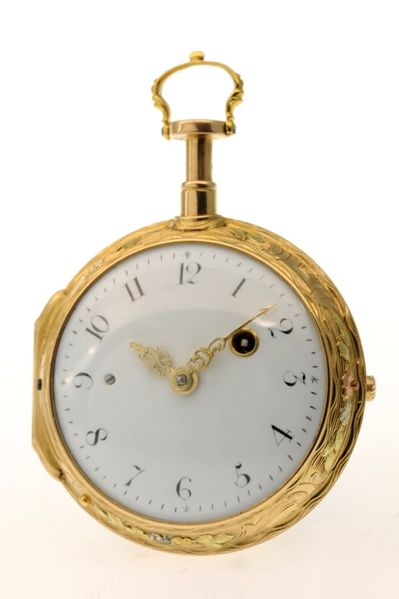Datei:Jean Baptiste Baillon à Paris, 46 mm, 99 g, circa 1770 (1).jpg

Originaldatei (683 × 1.025 Pixel, Dateigröße: 96 KB, MIME-Typ: image/jpeg)
Jean Baptiste Baillon à Paris, 46 mm, 99 g, circa 1770

|
Alle Bildrechte liegen bei dem Auktionshaus Auktionen Dr. H. Crott. Diese Abbildung ist urheberrechtlich geschützt und steht nicht unter einer freien Lizenz. Für anderweitige Nutzungen außerhalb von Watch-Wiki ist die schriftliche Zustimmung des Urheberrechtsinhabers nötig. |
Entzückende Goldemail-Spindeltaschenuhr "à quatre couleurs" mit Viertelstundenrepetition "Melpomene, die Muse der Tragödie" Geh.: Gold und polychromes Email, Schallöffnungen, Bodenglocke. Ziffbl.: Email. Werk: Vollplatinenwerk, Kette/Schnecke, 2 Hämmer, dreiarmige Stahlunruh.
Diese seltene Taschenuhr ist mit einem hochfeinen Emailmedaillon ausgestattet. In leuchtenden Emailfarben präsentiert sich Melpomene, die Muse der Tragödie, mit ernster Theatermaske und Weinlaubkranz in den Haaren. Zu ihrer Linken zwei kleine Knaben in Tüchern gehüllt beim Trompetespielen. Außergewöhnlich der vierfarbige Goldrand mit punziertem Weidenkorb, Schalmei und Strohhut, der in die Szene hereinragt.
A charming quarter repeating "à quatre couleurs" gold enamel verge pocket watch "Melpomene, the Muse of Tragedy" Case: gold and polychrome enamel, sound holes, rear bell. Dial: enamel. Movm.: full plate movement, chain/fusee, 2 hammers, three-arm steel balance.
This rare pocket watch is decorated with an extremely fine enamel medallion: Melpomene, the muse of tragedy, is shown in bright colours, with a dramatic theatre mask and a wreath of vine leaves in her hair. At her left are two small boys wrapped in shawls, playing the trumpet. The four-colour gold rim is extravagantly decorated with engravings of a wicker basket, a shalm and a straw hat that extends into the scene.
Jean-Baptiste Baillon (de Fontenay) was a very famous - and in the 18th century the richest - watch- and clockmaker in Paris. In 1727 he became a master; he had his own manufactory in Saint-Germain-en-Laye, where he had several makers working for him - quite unusual at the time. The factory was run by Jean Jodin (1715-1761); it closed in 1765. Ferdinand Berthoud was very impressed by Baillon's business, he admired its size and the excellent quality that was produced. In 1753 Berthoud wrote about Baillon's shop: "Nowadays this is the most beautiful and most wealthy watch shop. Diamonds are not only used for pocket watches but even for clocks". Around 1770 Baillon was appointed watch- and clockmaker to the court of Queen Marie Antoinette, "Premier Valet de Chambre and Valet de Chambre-Horloger Ordinaire de la Dauphine to Marie-Antoinette". In 1772 Jean-Baptiste-Albert Baillon died a very rich man. His assets were worth around 384.000 livres. Some of his works are today held by museums in Paris, Toulouse, Brussels, Florence, London und New York. Source: http://watch-wiki.de/index.php?title=Baillon,_Jean_Baptiste_(3), as of 03/22/2011
Dateiversionen
Klicke auf einen Zeitpunkt, um diese Version zu laden.
| Version vom | Vorschaubild | Maße | Benutzer | Kommentar | |
|---|---|---|---|---|---|
| aktuell | 21:12, 21. Okt. 2016 |  | 683 × 1.025 (96 KB) | Andriessen (Diskussion | Beiträge) | Jean Baptiste Baillon à Paris, 46 mm, 99 g, circa 1770 {{Bildrechte U|dem Auktionshaus Auktionen Dr. H. Crott}} {{Category Picture gallery watch models Baillon, Jean Baptiste (3)}} Entzückende Goldemail-Spindeltaschenuhr "à quatre couleurs" mi… |
Du kannst diese Datei nicht überschreiben.
Dateiverwendung
Keine Seiten verwenden diese Datei.
Metadaten
- Bildgalerie Uhrenmodelle Baillon, Jean Baptiste (3)
- Picture gallery watch models Baillon, Jean Baptiste (3)
- Galería de imagenes de modelos de relojes Baillon, Jean Baptiste (3)
- Afbeeldingen galerij uurwerkmodellen Baillon, Jean Baptiste (3)
- Фотогалерея Модели часов Baillon, Jean Baptiste (3)
- Galleria fotografica di modelli orologi Baillon, Jean Baptiste (3)